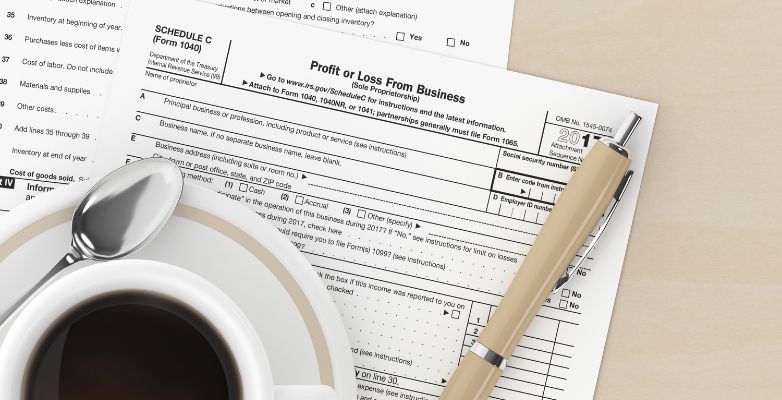For small business owners, the most typical business income tax form is the IRS Schedule C. The form is a component of your individual tax return. You can use Form 1040 to file your income taxes starting with the 2021-2022 tax year. For seniors (those over 65), the 1040-SR is offered with big text and a standard deduction chart.
The IRS assesses any taxes or refunds due by using the information in Schedule C to determine how much taxable profit you made.
Table of Content
What is Schedule C Form 1040?
You must disclose your sole proprietorship’s profit or loss on a Schedule C form. If you are operating your business continuously and on a regular basis, you are considered to be doing so with the intent to make a profit.
If you are engaging in a hobby or a not-for-profit activity, the IRS does not require Schedule C. However, since you work for yourself, which probably excludes you. You must submit a Schedule C if you are an independent contractor who intends to turn a profit from your firm.
The IRS uses the data you provide on Schedule C to calculate your profit in order to determine whether you owe taxes or will be eligible for a tax refund. If you operate more than one business, each Schedule C must be completed separately.
The Schedule C-EZ from the IRS, which was exactly what it sounds: EASY, used to make it even easier. It was a stripped-down version made for smaller companies, like those that didn’t take home office deductions. However, if you own a sole proprietorship as of the 2021-2022 tax year, you must use Schedule C.
Significant Points of Schedule C Form 1040
- Gathering information is the first step in preparing Schedule C.
- Fill out the form completely, making adjustments and additions as you go.
- You will receive a net income or loss figure from this process for your company. Together with any other income you received throughout the course of the year, including this sum on your individual tax return.
- If you had income (rather than a loss) for the year, you will also need to figure out the self-employment tax that is due (Social Security and Medicare for Small Business Owners). Your tax return should include the Self-Employment Tax obligation.
Use of Schedule C for Business Taxes
Schedule C is used by many businesses kinds to report their business taxes. The uses are:
- Sole proprietors are business owners who have not filed another type of business registration with their state (an LLC or corporation). These companies use Schedule C to record their business income while paying taxes.
- A husband-and-wife partnership-based business may convert to a Qualified Joint Venture and file two Schedule C forms for tax purposes rather than the more complex partnership form. Qualifications and restrictions apply to this election.
- If a single-member LLC hasn’t chosen to pay taxes as a corporation or S corporation, it must use Schedule C to file its taxes.
Who Needs to File Schedule C (Form 1040)
If you operate as a sole proprietor, you must probably file a Schedule C. If you operate multiple businesses, you must file a separate Schedule C for each one.
If the following applies to you then you are a sole proprietor:
- Your company isn’t a corporation or partnership, for example, or another type of legitimate business entity.
- You don’t report to a boss or manager who withholds money from your pay for taxes.
- Your company’s principal motivation is to generate revenue.
- It isn’t only a hobby for you; you transact business frequently (more on that below)
- As a single-member LLC, you are not taxed as an S corporation since you have not chosen to do so.
Prerequisites before Schedule C Form 1040 Filling:
Before filling out the form, you have to remember or check the following points:
- Instructions from the IRS for Schedule C
- Now, the Second step is that you have to Identify information, such as your SSN (Social Security Number)
- Enter Your Employer Identification Number, in case you have one.
- A tax year’s Income Statement
- Your year-end Balance Sheet
- Receipts or statements for any purchases made for company purposes, including simple ones like food expenses as well as more expensive ones like machinery, vehicles, or buildings
- Counting and valuing the inventory (if you sell products)
- Records of mileage
Steps for Completing Schedule C (Form 1040)
Follow the following steps in order to complete Schedule C Form 1040:
Information Gathering
The form requires three types of financial information about your company such as business income, cost of goods sold, and business expenses.
Detailed information regarding the sources of your business income should be gathered. Add allowances and returns.
Sold Goods Cost:
You’ll need to collect data if you have an inventory of goods that you’re trying to sell for this computation. You will require:
- Your technique of Inventory Valuation.
- Value of Inventory at the start of the year and Value of inventory at the end of the year.
- Cost of Supplies, Materials, and Labor.
Expenses of Business:
Assemble information regarding all business costs (they should be in your Profit and Loss statement), Include:
- Phone, Utility, Computer, and other office-related costs.
- Insurance for your business, such as property insurance and disability insurance.
- Supplies that are used in offices/companies etc.
- Wages you accrued. Additionally, the sums paid to non-employees.
- Interest paid on Loans, Leases, Mortgages, and other obligations owed by businesses.
- Only half of the meal costs may be deducted from income. No longer deductible are entertainment costs.
- On a tax return, It might be challenging to classify some costs.
Don’t hesitate to include all of these difficult-to-categorize expenses since you will be able to record additional charges in Part V of the form, Such as for miscellaneous expenses like petty cash on your business tax return.
Calculation of Income and Gross Profit
You can figure out your business’s revenue and gross profit now as you know your income and your cost of products sold.
Be sure to account for the cost of goods sold calculations. The computation must be done in Part III, Cost of Goods Sold. Then total the amounts on line 4 of the Income section.
- Net revenues are the sum of the gross sales proceeds fewer returns and allowances.
- Gross Profit = Net Revenue – Cost of Goods Sold.
- Gross Income = Gross Profit plus Other Income from Tax Credits or Other Sources.
Business Expenses Included
Lines 8 through 27 are an alphabetical list of business costs that you can deduct.
Employee perks and insurance, such as malpractice and property insurance, are all deductible along with depletion, depreciation, and Section 179 expenses, but health insurance is not.
Deductions for legal and professional fees, office costs, pension, and profit-sharing programs, as well as interest on mortgages and other business loans, are all permitted.
You can also write off expenses paying for repairs and maintenance, Supplies, Taxes and Permits, Meals and Entertainment, Utilities, Labor, and the cost of renting or leasing vehicles or other business equipment.
For “other” expenses, see line 27. They will be gathered in Form Part V, and the total will be transferred here.
Before you file your return, consult a tax expert because many of these business expenses have limitations or requirements that must be satisfied before they may be written off.
Payroll taxes, wages, and salaries are all deductible expenses. The whole amount of wages paid, the employer’s share of Social Security and Medicare taxes, unemployment benefits, and federal and state workers’ compensation insurance are all deductible costs.
Expenses and other Information
Line 30 – Home use for business: When reporting the cost of using your home for business purposes if you work from home, you have two choices:
- Option A is filling out Form 8829, which involves figuring out the space of your entire home and allocating a portion for your home-based business. Line 30 of Schedule C should provide the total permissible expenses that came out of those computations.
- Option B uses a more straightforward formula: $5 per square foot of home office space up to 300 square feet, with a $1,500 deduction cap. Line 30’s appropriate fields require the entry of this data. Regardless of how you determine the deduction, you can only use space that is frequently and only for your business.
Part IV: Details about your car there are no calculations to provide in your Schedule C; this is merely an informational element. The distance you traveled for work, commuting, and other reasons must all be disclosed here.
Part V -Other Expenses: Here, you can go into greater detail about any additional costs you’re writing off. Include your phone, Internet Service provider, and website costs here, along with any other ancillary costs like bank fees. Line 27 contains the total for these additional costs.
Net Income Calculation
The outcome is the net income calculation:
- Line 28 should be filled out with total expenses. Line 29 should be your estimated profit.
- You can find your net profit or loss on line 31 by subtracting the costs associated with using your house for business purposes from line 30.
Moreover, If You Suffer a Business Loss
If your Schedule C indicates that you have incurred a business loss (expenses exceed income), you must indicate on lines 32a and 32b whether or not your loss is susceptible to further occurrence. (The majority of small business owners assume the entire risk if they are actively involved in the company.) If you suffer a business loss, you might be required to file Form 461, Limitation on Business Losses.
Final Step
Adding Schedule C Form 1040 to Tax Return:
Transfer your Schedule C’s line 31’s net profit or loss to Schedule 1;s line 12 on your Form 1040. Do not include any wages received from an employer when calculating your income or loss from this business when compared to other income or losses from other businesses.
Frequently Asked Questions
Who is a Sole Proprietorship?
An unincorporated business that is owned and operated by just one person is known as a sole proprietorship. It also implies:
• You have a right to get all the profits.
• Any losses and liabilities are your responsibility.
Independent contractors, freelancers, and one-person enterprises typically operate in this capacity, and the majority of these small business owners file Schedule C forms. It ensures that the profits are only taxed once by classifying your company as a “pass-through” entity for tax reasons.
How Can You Complete the Schedule C Form?
According to your small business, Schedule C requests the information listed below:
• Business Address Your method of accounting
• a good or service
• EIN, or Employer Identification Number (Not the same as your Social Security number)
• Revenue Statement
• Balance Sheet
• Records of inventory
• Cost of goods sold Receipts and business costs
• Vehicle records, auto and truck expenses, and business mileage logs
• Name
Your net profit or loss is determined by deducting all of your business expenses from your income. You calculate this information in Schedule C. Any net profit is then reported on your 1040 income tax form as income to the IRS.
What are the Five Sections of Schedule C?
Following are the five sections of schedule C are:
• First Section: Add up your sales and record your cost of products sold to determine your total income.
• Second Section: Expenses for business: There are 12 different types of company costs that can be deducted, so make sure to mention them all. Several examples include working from home and the legal and professional sectors. Your net profit is determined by subtracting the total of these costs from your gross profit. This amount represents your personal tax return’s taxable income. You may be able to deduct any net losses you had this year from your 1040.
• Third Section: Aids in determining your cost of products sold (COGS). If your company provides services, this section does not apply to you.
• Forth Section: Vehicle and truck expenses for work-related travel.
• Fifth Section: Other company expenses that don’t fall under the headings in Part 2. Remember that in order to qualify as a business expense for tax purposes, a cost “must be both usual and required.”
What do You Understand by Schedule C-EZ?
A Schedule C-EZ will ease your tax burden if you run a very small business. If your company satisfies the following requirements, you may utilize this condensed form of the Schedule C:
• Use the Cash Basis of Accounting
• Maximum $5,000 in Expenses for that Tax Year
• No Net Loss
• No Workers
• No Inventory One Company only
• There is no Deduction for Residential use by a Lone Proprietor.




